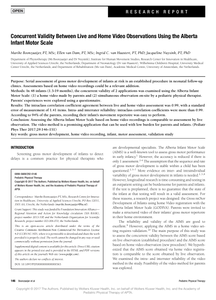Background: Current use of smartphone cameras by parents create opportunities for longitudinal home-video-assessments to monitor infant development. We developed and validated a home-video method for parents, enabling Pediatric Physical Therapists to assess infants’ gross motor development with the Alberta Infant Motor Scale (AIMS). The objective of the present study was to investigate the feasibility of this home-video method from the parents’ perspective. Methods: Parents of 59 typically developing infants (0–19 months) were recruited, 45 parents participated in the study. Information about dropout was collected. A sequential mixed methods design was used to examine feasibility, including questionnaires and semi-structured interviews. While the questionnaires inquired after the practical feasibility of the home-video method, the interviews also allowed parents to comment on their feelings and thoughts using the home-video method. Results: Of 45 participating parents, 34 parents returned both questionnaires and eight parents agreed to an interview. Parent reported effort by the infants was very low: the home-video method is perceived as similar to the normal routine of playing. The parental effort level was acceptable. The main constraint parents reported was time planning. Parents noted it was sometimes difficult to find the right moment to record the infant’s motor behavior, that is, when parents were both at home and their baby was in the appropriate state. Technical problems with the web portal, reported by 28% of the parents were also experienced as a constraint. Positive factors mentioned by parents were: the belief that the home videos are valuable for family use, receiving feedback from a professional, the moments of one-on-one attention and interaction with their babies. Moreover, the process of recording the home videos resulted in an increased parental awareness of, and insight into, the gross motor development of their infant. Conclusion: The AIMS home-video method is feasible for parents of typically developing children. Most constraints are of a practical nature that can be addressed in future applications. Future research is needed to show whether the home-video method is also applicable for parents with an infant at risk of motor development problems.
DOCUMENT

This thesis focuses on topics such as preterm birth, variation in gross motor development, factors that influence (premature) infant gross motor development, and parental beliefs and practices. By gaining insight into these topics, this thesis aims to contribute to clinical decision-making of paediatric physiotherapists together with parents, and with that shape early intervention.
DOCUMENT

The purpose of this study was a serial assessment of gross motor development of infants at risk is an established procedure in neonatal follow-up clinics. Assessments based on home video recordings could be a relevant addition. In 48 infants (1.5-19 months), the concurrent validity of 2 applications was examined using the Alberta Infant Motor Scale: (1) a home video made by parents and (2) simultaneous observation on-site by a pediatric physical therapist. Parents’ experiences were explored using a questionnaire.
DOCUMENT

Het Godivapp Applied in Pediatric Primary care (GoAPP) project ontwikkelt, onderzoekt en realiseert de implementatie van een e-health applicatie voor uitwisseling van videomateriaal in zelfstandige praktijken (MKB) in de eerstelijnsgezondheidszorg. Voor een goede analyse van bewegingsproblemen bij baby?s uit risicogroepen is het van belang de motorische ontwikkeling te meten en te volgen in de tijd. Kinderfysiotherapeuten gebruiken hiervoor een observatie-instrument, de Alberta Infant Motor Scale (AIMS). In 2014 en 2015 heeft de GODIVA-onderzoeksgroep (GrOss motor Development of Infants using home Video registration with the AIMS) van Hogeschool Utrecht een methode ontworpen, waarbij de ontwikkeling gevolgd kan worden aan de hand van video?s gemaakt door ouders. De methode wordt door professionals gezien als een aanvulling op bestaande methoden, die het monitoring van kinderen doelmatiger en transparanter maakt. De methode past uitstekend in de huidige e-health ontwikkeling en zelfmanagement/empowerment van ouders. Voor research met de videomethode is een prototype applicatie ontwikkeld waarmee op veilige wijze de filmbeelden verstuurd kunnen worden en opgeslagen. Het prototype is nog niet geschikt voor gebruik binnen de beroepspraktijk. Eerstelijns Kinderfysiotherapiepraktijken zouden graag de applicatie gebruiken. Zij verwachten dat het een waardevolle uitbreiding is van hun mogelijkheden en een kans om als praktijk te innoveren. Zij zien, als zelfstandige ondernemers, echter ook belemmeringen, zoals ICT-ondersteuning en een passende tarifering van een videoconsult. Voor deze kleine bedrijven spelen ook betaalbaarheid en gebruiksgemak een essentiële rol. Binnen GoAPP zijn vijf perspectieven voor innovatie en implementatie van e-health bij elkaar gebracht: eindgebruikers, zorginhoudelijk, harde technologie, zachte technologie en bedrijfskundig perspectief. Georganiseerd rondom drie werkpakketten wordt interdisciplinair onderzoek gedaan naar (1) optimalisatie van het videoportal, (2) implementatie, en (3) bedrijfskundige haalbaarheid, via ontwerpgericht onderzoek, literatuuronderzoek, implementatieanalyse en business-case onderzoek. Een vierde werkpakket richt zich op doorgroei van het netwerk kinderfysiotherapeuten naar een Community of Practice. Doel: Een innovatieve videomethode voor het observeren van de motoriek van zuigelingen, geschikt voor eerstelijnspraktijken kinderfysiotherapie, met een passend implementatieplan en business modelling.